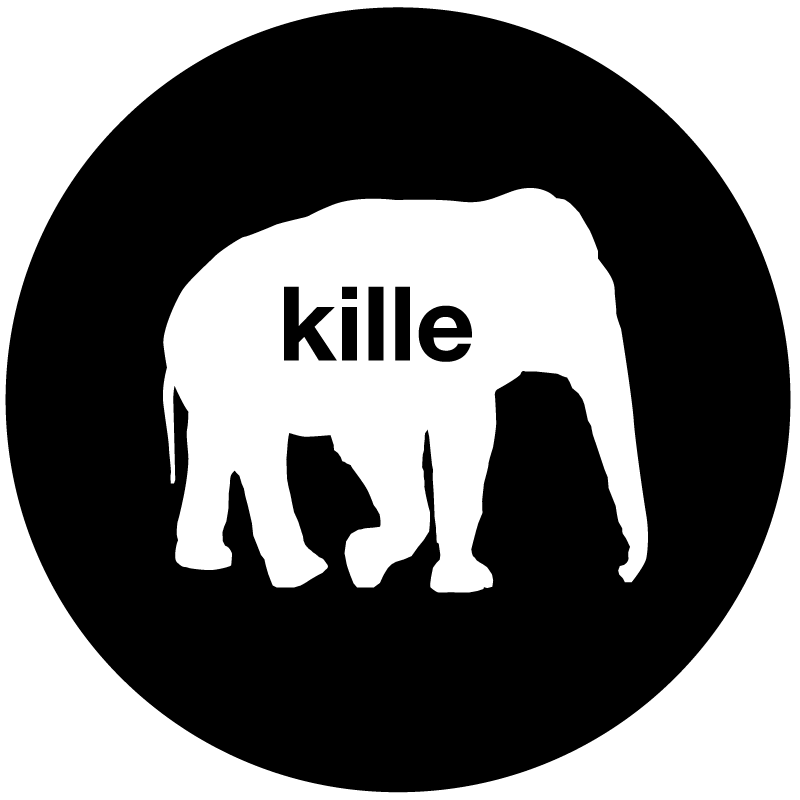By Damon Orion, for Santa Cruz Waves
-
At the time that Jeremiah Kille sold his first painting, art was secondary to him. While working toward a degree in pictorial arts at San Jose State, he also maintained a shop in Westside Santa Cruz, where he shaped surfboards under two different labels, Conspiracy and Current.
In this piece, titled “Tommy’s Not Coming Home #1” and others, Kille explores the displacement of elephants after the heyday of circuses.
Kille’s life took a turn when he displayed some of his art at Verve Coffee Roasters. “I just needed a place to hang my paintings,” he con- fesses. “I was painting pretty large. At the time, we were in a small condo, and I didn’t have any place to store them.”
To his surprise, coffee shop patrons started asking about pricing. “I was pretty floored by that,” recalls the painter, who sold his first painting in 2007. “That wasn’t the original idea for having it sitting there.” After 10 years of crafting surfboards—and when his then-wife was pregnant with their first son—he decided to try something new. Thus began his unexpected career as an artist.
Kille’s work, which often contains such surfboard-shaping materials as resin and cloth inlay, is rich with subtle layers of mean- ing. Though much of it is vibrant in both color and content, it is also informed by the artist’s fascina- tion with impermanence. “I guess everything has a shelf life, so
to speak,” Kille muses. “That’s something I think about a lot when I’m in my studio, and it comes out in the work. Growing up, I had a couple of friends die pretty early, so I was exposed to that.” He adds that his ex-wife is a cancer nurse at Stanford. “I’ve always been really interested in the work she does, the patients she works with and their families, and how people handle their relationship with death.”
“Indefinido” is one in a series of paintings depicting the battle between matador and bull.
The more somber undertones of Kille’s art are often buried in the most literal sense. “A lot of the work I end up doing is pretty layered,” he notes. “A lot of times, there are ideas and thoughts that I have that I’ll scribble on the canvas or actually
write out. A lot of those end up getting covered up. You might see a small remnant of it, but you’re not going to know what it said or what it was. It’s almost like a journal for me, and I don’t necessarily want people reading my journal. Some of the things that I’ll write down are personal or maybe a little bit crazy.
One of the recurring images in Kille’s work is that of displaced circus elephants, a subject he began delving into while he was in art school. “The early 20th cen- tury circus was kind of this big, grand thing that would travel and that people would travel to see,” he notes, adding that the elephants were the main attraction in these events. Kille’s first paintings to explore this motif were based on the idea of elephants being put out of work at a time when “the circus died, in a sense.
Kille got a surprising insight into his own interest in elephants after the birth of his first son. At that time, Kille’s mother gave him a box of items from his childhood, one of which was a blanket embla- zoned with images of elephants. “When I saw it, it kind of made sense: there were a lot of little knickknacks or things around the house that were elephant icons,” he says.
The painter adds that a couple of years ago, while watch- ing Dumbo with his kids for the first time in more than 30 years, he realized that the movie had probably inspired much of the imagery in his work. Of particular interest was the opening scene, in which a menagerie of animals is riding a train from one site to the next. “There’s a thunder and lightning storm, and the animals are scared,” Kille explains. “It’s interesting, because I think a lot of my landscapes with elephants in them look a lot like that. I guess a lot of those things just kind of got buried somewhere subconsciously.”
When he’s not watching movies with his kids, painting or shaping boards, Kille spends his time surfing and riding for Team Caletti, a local cyclocross racing team. “If I’m in the studio too much, I think my work starts to suffer,” he says. “Being able to be outside, whether it’s out on a trail, up in the redwoods, or in the water, gives me the mental space [I need for inspiration].” If he hasn’t surfed for a while, he finds himself painting waves into the horizons of his landscapes.
As a father of two, Kille understands the value of the bottom line. As such, he feels
fortunate to be in a position to support himself through his art. “At the end of the day, if I wasn’t mak- ing money painting, I might be painting on the weekends here and there,” he says. “But you’ve got to make money to survive, and fortunately, I’m starting to be able to do that with art.”
